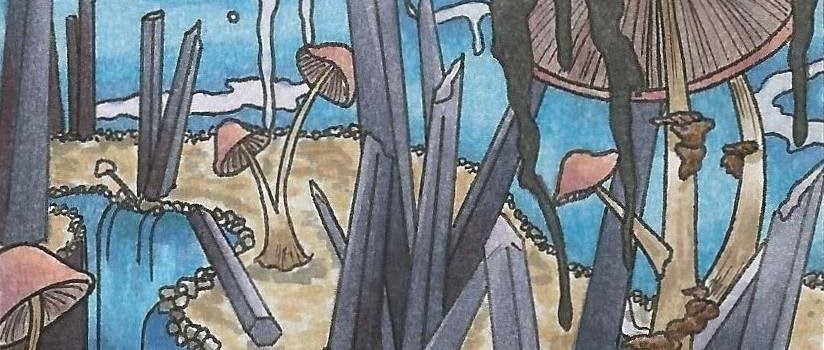Occasionally however travelers may see something on the far-off horizon of this flatland, something which is initially a novelty just for its existence: what appears to be a small forest or other mass of growth. Those with keen eyes, clever optics, or a modicum of patient approach may note that the shape isn't quite right though. That and, this "forest" is clearly moving. Upon drawing nearer, the shapes become more distinct: almost as if bamboo were growing out of a shrubbery. A tree upside down. It's at this point that the noise also becomes noticeable, as these long poles occasionally cross or slam into each other and a loud resonating carries across the flat land. Should it be a stormy day, some travelers may even see stray bolts of lightning strike into this moving mass and spark with terrifying brilliance.
It is at this point that most travelers steer themselves in another direction from the clanging mass. They have goods to peddle or places to be, and so they are content to continue their travels and merely bicker over myths and rumors. This is doubly true in those who have heard the ghost stories of those brave enough to investigate further, who were found as charred piles in the brush.
__________
Those who seek the truth of the rumors and venture closer hear the clanging become the backing to a cacophony of reverberating bleating. Before them stands nothing more, then a peculiar flock of sheep.
Their wool grows coarse, dark, and dense- and appears to be made of fine metal. As they move lightning visibly crackles underneath its surface, wafting off the smell of ozone within the vicinity. The previously mentioned rods are actually long poles of some strange metal, extending directly from the center of their spine far above them and into the air. This makes them weighted too awkwardly for normal movement, causing the aforementioned clanging and noise as they are prone to tipping over.
It is also at this point that the unskilled traveler often dies- either from reaching out to touch this oddity and dying from the discharge of the sheep, or after being gutted by their strange shepherds fresh from righting a sheep onto its feet.
They blend into the terrain, with forms that look as if someone shattered statuary made from the local sun-baked earth and repurposed it to new ends. Stiff pieces of rubble, bolted together with joints and straps and made to move. Up close one can see the expressions of their faces: perfectly sculpted features frozen into all manner of different expressions. The origins of these strange shepherds is unclear, but their purpose can be quite clearly discerned from their behaviors. They do not merely protect their flock, but they create them.
Whenever a baby lamb is born from the herd it is indistinguishable from a normal lamb, because it is one. Only through the efforts of the shepherds will it ever become anything different. While it is being reared during the dry season, instead of suckling at it's mother it is coaxed into licking at specific veins of metal found in the local area. This process is done with a strange and disputed methodology, as the herd moves in a pattern only known by the shepherds guiding them. All that is known for certain is that despite this practice, the young sheep would appear to grow hardy. Instead of heavy metal poisoning, they merely have the aforementioned strange wool.
Eventually, just before the wet season rolls in, the shepherds will use some of the wool harvested from other sheep to form long cords of fine wire. Using this wire, they begin to sew into the flesh and bones of the lambs. A small group of the shepherds will work so lightning quick the sheep do not even notice, all together at once passing and spinning the wire until it forms a rod of almost wicker-like manufacture. Once the wet season sets in, the herd moves to follow the darkest storm clouds. Lightning continuously strikes the herd, bewildering but otherwise not harming the slowly moving beasts. With each strike not only does the lightning rod smooth and fuse with the sheep, but charge the beast with the very lightning itself. Without the proper shearing regularly given by the shepherds, a single touch of a sheep's wool is enough to discharge a deadly bolt.
__________
Among scholars, the enduring question of why any of this occurs remains. Many promising lines of questioning have been proposed and are being researched.
Perhaps the shepherds use the lightning trapped within the sheep as a sort of fuel to sustain themselves? Scholars have found that the occasional sheep does appear to go missing from the flock, and the shepherds must maintain themselves in some regard.
Ancient documents have suggested that massive beings once fought by hurling lightning at one another. Along this line, a recent expedition has claimed to use an ancient coin to barter for one of the sheep, and since developed a pair of gloves with which one may wield it like a maul which may hurl a single bolt lightning. Perhaps this is their purpose?
A minor noble has recently proposed an eccentric plan. They intend to disguise themselves as a lamb to not only observe the shepherds in a closer way, but to also undergo this galvanizing process themselves. What might this discovery mean, but more importantly: what damn fool adventurers would aid such a thing?
